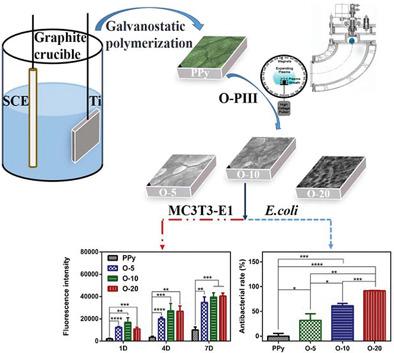当前位置:
X-MOL 学术
›
Adv. Mater. Interfaces
›
论文详情
Our official English website, www.x-mol.net, welcomes your
feedback! (Note: you will need to create a separate account there.)
Antibacterial Property and Biocompatibility of Polypyrrole Films Treated by Oxygen Plasma Immersion Ion Implantation
Advanced Materials Interfaces ( IF 4.3 ) Pub Date : 2020-03-11 , DOI: 10.1002/admi.202000057 Xiaoou Li 1, 2 , Jiajun Qiu 1, 2 , Xuanyong Liu 1, 2
Advanced Materials Interfaces ( IF 4.3 ) Pub Date : 2020-03-11 , DOI: 10.1002/admi.202000057 Xiaoou Li 1, 2 , Jiajun Qiu 1, 2 , Xuanyong Liu 1, 2
Affiliation

|
Polypyrrole (PPy) films obtained by oxidative polymerization have positive charges in its main chains and therefore exhibit antibacterial properties to some extent. However, antibacterial activities of PPy films for biomedical applications are still insufficient. Here, to endow PPy films with excellent antibacterial properties and biocompatibility, oxygen plasma immersion ion implantation (O‐PIII) is performed to regulate their physicochemical properties, including but not limited to wettability and surface charge. Escherichia coli, Staphylococcus aureus, and MC3T3‐E1 cells are utilized to investigate the antibacterial properties and cytocompatibility, respectively. Results show that antibacterial property of PPy films against E. coli is enhanced after O‐PIII treatment, and it becomes more outstanding with the increase of implantation time, which may be ascribed to the improved hydrophilicity and change of sample surfaces from negatively charged to positively charged. The similar results cannot be found from S. aureus due to different cell membrane structure. Meanwhile, O‐PIII can significantly improve the biocompatibility of PPy films.
中文翻译:

氧等离子体浸没离子注入处理的聚吡咯膜的抗菌性能和生物相容性
通过氧化聚合获得的聚吡咯(PPy)膜在其主链中带有正电荷,因此在一定程度上显示出抗菌性能。但是,PPy膜对生物医学应用的抗菌活性仍然不足。为了赋予PPy薄膜优异的抗菌性能和生物相容性,我们进行了氧等离子体浸没离子注入(O-PIII)来调节其理化特性,包括但不限于润湿性和表面电荷。大肠杆菌,金黄色葡萄球菌和MC3T3-E1细胞分别用于研究抗菌特性和细胞相容性。结果表明,PPy薄膜对大肠杆菌具有抗菌作用。经过O-PIII处理后,其离子强度增加,并且随着注入时间的增加而变得更加出色,这可能归因于亲水性的提高以及样品表面从带负电变为带正电的变化。由于细胞膜结构不同,因此无法从金黄色葡萄球菌中找到相似的结果。同时,O-PIII可以显着提高PPy膜的生物相容性。
更新日期:2020-03-11
中文翻译:

氧等离子体浸没离子注入处理的聚吡咯膜的抗菌性能和生物相容性
通过氧化聚合获得的聚吡咯(PPy)膜在其主链中带有正电荷,因此在一定程度上显示出抗菌性能。但是,PPy膜对生物医学应用的抗菌活性仍然不足。为了赋予PPy薄膜优异的抗菌性能和生物相容性,我们进行了氧等离子体浸没离子注入(O-PIII)来调节其理化特性,包括但不限于润湿性和表面电荷。大肠杆菌,金黄色葡萄球菌和MC3T3-E1细胞分别用于研究抗菌特性和细胞相容性。结果表明,PPy薄膜对大肠杆菌具有抗菌作用。经过O-PIII处理后,其离子强度增加,并且随着注入时间的增加而变得更加出色,这可能归因于亲水性的提高以及样品表面从带负电变为带正电的变化。由于细胞膜结构不同,因此无法从金黄色葡萄球菌中找到相似的结果。同时,O-PIII可以显着提高PPy膜的生物相容性。











































 京公网安备 11010802027423号
京公网安备 11010802027423号